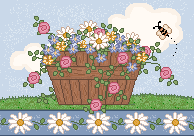
|
Mrs. McAbee |

|
Mrs. McAbee's class joined the Spring Into Life Internet Project created by Pattie Knox and Susan Silverman. We began by selecting animals that begin new life, become active, or experience seasonal changes in the spring. Each student selected a different animal to research. We learned defining characteristics for mammals, reptiles, birds, fish, amphibians, insects, arachnids, mollusks, and crustaceans. We completed questionnaires about our animals through Internet research in the computer lab, and researching reference and other nonfiction materials in the media center. Mrs. McCrary, our media specialist, taught us how to take notes properly without copying whole sentences. We organized our collected information into paragraphs to write reports. After writing a rough draft, we edited our work and made final copies. We created idea webs using Kidspiration to show related pieces of information. We illustrated life cycles and/or habitats of our selected animals. Please click here to see more of our work.
|
|
The Trapdoor
Spider The Trapdoor spider is one of many spiders. It is classified as an arachnid. It lives in California and Eastern America. The adult female Trapdoor spider lays eggs. In 3 to 4 months the baby spiderlings hatch. The Trapdoor spider eats mostly insects, but sometimes other spiders and even baby chicks! It lives in a twelve inch burrow. That's as big as a ruler! Its burrow is lined with silk. It has many dangers such as: lizards, birds, definitely the wasp, DDT and other bug sprays. It protects itself by biting. running in burrows, and eating what's chasing it!
|
|
The Black
Bear The black bear is a mammal. It lives in Alaska, Canada, Minnesota, Wisconsin and Michigan. Its habitat is primarily forests and swamps. It eats fish, salmon, and grass. Black bears fish for food. Its dangers are bigger bears and humans. Sometimes its habitat is destroyed by people who cut down forests for buildings. Its protection against other animals is scratching or mauling. Bears slow down in fall, and eat a lot. Then they hibernate. In the west, they can be black to cinnamon in color, with a white blaze on the chest. Black bears can weigh 800 pounds or more.
|
|
The
Grasshopper The grasshopper lives almost everywhere on earth where there is grass. Grasshoppers are often found on farms. They can do great damage to crops. The female grasshopper lays her eggs. When the nymphs hatch from their eggs they eat and often do great damage. When the plant is eaten the nymphs molt for the 5th time and become an adult and fly off in swarms of up to 40 million grasshoppers or locusts.
|
|
The Luna
Moth The Luna Moth is an insect. It lives in North America in deciduous forests. It eats leaves of the hickory, sweet gum, walnut and, when in its larva stage, sometimes other trees. Some dangers it faces are pollutants and pesticides. Its lime green color allows it to hide among leaves for protection from predators. The Luna Moth is lime green. It has four wings and two tails in the back of it. The Luna Moth is bigger than most butterflies. It is nocturnal but sometimes you see it in the day. The Luna Moth migrates too.
|
|
The
White-Tailed Deer A White-Tailed Deer is a mammal. It lives in the southern half of the southern tier of Canadian provinces and most of the U. S., except for the southwest. White-Tailed Deer are found in farmlands, bushy areas, woods, suburbs, and gardens. Size varies greatly, but most are small to medium sized deer. Their color is tan or reddish brown in summer, and grayish brown in winter. The fawn is spotted. They eat tender grass and twigs. Deer have mountain lions, wolves, and hunters for enemies. The deer's antlers and ability to run fast help keep it safe. Its coloring helps it hide in the woods
|
|
The Pileated
Woodpecker The pileated woodpecker is one of two hundred species of woodpeckers and is classified as a bird. It lives in British Columbia and various places in the United States. It lives in mature forests and borders. Its food source is carpenter ants from trees, suet and birdseed. Its dangers are people because they cut down the trees the woodpeckers live in. To protect itself it flies to a different tree. The adult lays four to five eggs and in two to three weeks they hatch. The mother feeds her babies until they are ready to live on their own. The pileated woodpecker is 17 inches tall. It is a crow-sized woodpecker. Its color is black with white neck stripes. It has white wing linings and a large red crest.
|
|
The Frog by Foofoo A frog is an amphibian. Frogs live all around the world. The frog lives mostly around swamps, ponds and forest. Frogs eat worms and other insects. They catch them with their long, sticky tongues. A frog's dangers are snakes and polluted areas. Its protection is camouflage and strong back legs. The female lays her eggs. The eggs hatch 15 weeks later into tadpoles. Tadpoles have gills like fish. The tadpole grows back legs, then front legs. It continues to grow and change into an adult frog with lungs for living on land.
|
|
Some of the Georgia QCC Objectives
addressed are: Language Arts LA2.44 - Communicates ideas by using the writing process LA2.57 - Uses easy fiction/nonfiction books, audiovisual resources, software, and periodicals as information resources. Science S2.2 - Uses books and other media to obtain information related to science concepts. |